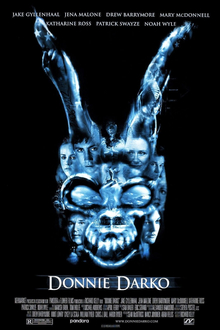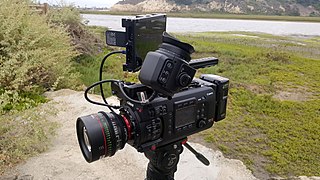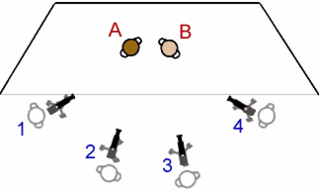
Donnie Darko is a 2001 American science fiction psychological thriller film written and directed by Richard Kelly and produced by Flower Films. It stars Jake Gyllenhaal, Jena Malone, Maggie Gyllenhaal, Drew Barrymore, Mary McDonnell, Katharine Ross, Patrick Swayze, Noah Wyle, Stu Stone, Daveigh Chase, James Duval, and Seth Rogen. Set in October 1988, the film follows Donnie Darko, an emotionally troubled teenager who inadvertently escapes a bizarre accident by sleepwalking. He has visions of Frank, a mysterious figure in a rabbit costume who informs him that the world will end in just over 28 days.

A production sound mixer, location sound recordist, location sound engineer, or simply sound mixer is the member of a film crew or television crew responsible for recording all sound recording on set during the filmmaking or television production using professional audio equipment, for later inclusion in the finished product, or for reference to be used by the sound designer, sound effects editors, or foley artists. This requires choice and deployment of microphones, choice of recording media, and mixing of audio signals in real time.

A movie camera is a type of photographic camera that rapidly takes a sequence of photographs, either onto film stock or an image sensor, in order to produce a moving image to display on a screen. In contrast to the still camera, which captures a single image at a time, the movie camera takes a series of images by way of an intermittent mechanism or by electronic means; each image is a frame of film or video. The frames are projected through a movie projector or a video projector at a specific frame rate to show the moving picture. When projected at a high enough frame rate, the persistence of vision allows the eyes and brain of the viewer to merge the separate frames into a continuous moving picture.
A hard disk recorder (HDR) is a system that uses a high-capacity hard disk to record digital audio or digital video. Hard disk recording systems represent an alternative to reel-to-reel audio tape recording and video tape recorders, and provide non-linear editing capabilities unavailable using tape recorders. Audio HDR systems, which can be standalone or computer-based, are typically combined with provisions for digital mixing and processing of the audio signal to produce a digital audio workstation (DAW).

A clapperboard, also known as a dumb slate, is a device used in filmmaking and video production to assist in synchronizing of picture and sound, and to designate and mark the various scenes and takes as they are filmed and audio-recorded. It is operated by the clapper loader. It is said to have been invented by Australian filmmaker F. W. Thring.

A camcorder is a self-contained portable electronic device with video and recording as its primary function. It is typically equipped with an articulating screen mounted on the left side, a belt to facilitate holding on the right side, hot-swappable battery facing towards the user, hot-swappable recording media, and an internally contained quiet optical zoom lens.

A professional video camera is a high-end device for creating electronic moving images. Originally developed for use in television studios or with outside broadcast trucks, they are now also used for music videos, direct-to-video movies, corporate and educational videos, wedding videos, among other uses. Since the 2000s, most professional video cameras are digital professional video cameras.
Filmmaking or film production is the process by which a motion picture is produced. Filmmaking involves a number of complex and discrete stages, starting with an initial story, idea, or commission. It then continues through screenwriting, casting, pre-production, shooting, sound recording, post-production, and screening the finished product before an audience that may result in a film release and an exhibition. Filmmaking occurs in a variety of economic, social, and political contexts around the world. It uses a variety of technologies and cinematic techniques.

Principal photography is the phase of producing a film or television show in which the bulk of shooting takes place, as distinct from the phases of pre-production and post-production.

HDV is a format for recording of high-definition video on DV videocassette tape. The format was originally developed by JVC and supported by Sony, Canon, and Sharp. The four companies formed the HDV Consortium in September 2003.
Sync sound refers to sound recorded at the time of the filming of movies. It has been widely used in movies since the birth of sound movies.
A film school is an educational institution dedicated to teaching aspects of filmmaking, including such subjects as film production, film theory, digital media production, and screenwriting. Film history courses and hands-on technical training are usually incorporated into most film school curricula. Technical training may include instruction in the use and operation of cameras, lighting equipment, film or video editing equipment and software, and other relevant equipment. Film schools may also include courses and training in such subjects as television production, broadcasting, audio engineering, and animation.
Film-out is the process in the computer graphics, video production and filmmaking disciplines of transferring images or animation from videotape or digital files to a traditional film print. Film-out is a broad term that encompasses the conversion of frame rates, color correction, as well as the actual printing, also called scannior recording.
In filmmaking, dailies are the raw, unedited footage shot during the making of a motion picture. The term comes from when movies were all shot on film because usually at the end of each day, the footage was developed, synced to sound, and printed on film in a batch for viewing the next day by the director, selected actors, and film crew members. After the advent of digital filmmaking, "dailies" were available instantly after the take and the review process was no longer tied to the overnight processing of film and became more asynchronous. Now some reviewing may be done at the shoot, even on location, and raw footage may be immediately sent electronically to anyone in the world who needs to review the takes. For example, a director can review takes from a second unit while the crew is still on location or producers can get timely updates while travelling. Dailies serve as an indication of how the filming and the actors' performances are progressing. The term was also used to describe film dailies as "the first positive prints made by the laboratory from the negative photographed on the previous day".
A production company, production house, production studio, or a production team is a studio that creates works in the fields of performing arts, new media art, film, television, radio, comics, interactive arts, video games, websites, music, and video. These groups consist of technical staff to produce the media, and are often incorporated as a commercial publisher. Generally the term refers to all individuals responsible for the technical aspects of creating a particular product, regardless of where in the process their expertise is required, or how long they are involved in the project. For example, in a theatrical performance, the production team has not only the running crew, but also the theatrical producer, designers and theatrical direction.

The multiple-camera setup, multiple-camera mode of production, multi-camera or simply multicam is a method of filmmaking and video production. Several cameras—either film or professional video cameras—are employed on the set and simultaneously record or broadcast a scene. It is often contrasted with a single-camera setup, which uses one camera.

S. Darko, also known as S. Darko: A Donnie Darko Tale, is a 2009 American science fiction thriller film directed by Chris Fisher and starring Daveigh Chase, Briana Evigan, and Ed Westwick. It is the sequel to the 2001 cult film Donnie Darko.

A film – also called a movie, motion picture, moving picture, picture, photoplay or (slang) flick – is a work of visual art that simulates experiences and otherwise communicates ideas, stories, perceptions, feelings, beauty, or atmosphere through the use of moving images. These images are generally accompanied by sound and, more rarely, other sensory stimulations. The word "cinema", short for cinematography, is often used to refer to filmmaking and the film industry, and to the art form that is the result of it.
Articles related to the field of motion pictures include:

Leonie Pray House, also known as "Dawson-Pray House," is a Long Beach Historic Landmark located in the Los Cerritos neighborhood of Long Beach, California. It is a 6,500-square-foot (600 m2) English Tudor Revival mansion designed by architect Clarence Aldrich. It has been used as a filming location for films and television series, including Donnie Darko, Not Another Teen Movie, Weird Science, and Beverly Hills, 90210.


















